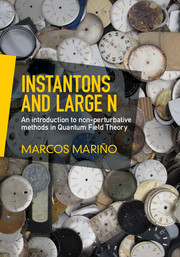Book contents
- Frontmatter
- Contents
- Preface
- Part I Instantons
- 1 Instantons in Quantum Mechanics
- 2 Unstable vacua in Quantum Field Theory
- 3 Large order behavior and Borel summability
- 4 Non-perturbative aspects of Yang–Mills theories
- 5 Instantons and fermions
- Part II Large N
- Appendix A Harmonic analysis on S3
- Appendix B Heat kernel and zeta functions
- Appendix C Effective action for large N sigma models
- References
- Author Index
- Subject Index
4 - Non-perturbative aspects of Yang–Mills theories
from Part I - Instantons
Published online by Cambridge University Press: 05 September 2015
- Frontmatter
- Contents
- Preface
- Part I Instantons
- 1 Instantons in Quantum Mechanics
- 2 Unstable vacua in Quantum Field Theory
- 3 Large order behavior and Borel summability
- 4 Non-perturbative aspects of Yang–Mills theories
- 5 Instantons and fermions
- Part II Large N
- Appendix A Harmonic analysis on S3
- Appendix B Heat kernel and zeta functions
- Appendix C Effective action for large N sigma models
- References
- Author Index
- Subject Index
Summary
Introduction
Non-Abelian gauge theories are the fundamental building block of the Standard Model of elementary particles. In the case of pure Yang–Mills (YM) theory (describing the interaction of gluons) and QCD (describing the interactions of gluons and fermions in the fundamental representation of the gauge group), a purely perturbative approach is only useful at high energies, due to the fundamental property of asymptotic freedom. In fact, at low energies, YM theory displays a number of phenomena which cannot be seen in perturbation theory. The first phenomenon is the existence of a mass gap. This means that, when the theory is quantized in a very large volume, the ground state energy is strictly positive. The second phenomenon is confinement: if we consider non-dynamical quarks in the theory, the energy between a quark and an antiquark grows linearly with their separation. Therefore, the spectrum of physical states of the theory consists of color singlets. Finally, in QCD we have the phenomenon of chiral symmetry breaking, i.e. the spontaneous breaking of chiral symmetry, which we will review in some detail below. All of these phenomena resist analytic treatment in conventional YM QCD theories, and in particular in conventional perturbation theory, although some of them can be addressed in simpler toy models. It is then of the highest interest to develop non-perturbative techniques in the study of non-Abelian gauge theories.
In this chapter we will study some non-perturbative aspects in YM theories. As we saw in the study of instantons in QM, in order to understand non-perturbative effects it is useful to focus on quantities which are invisible in perturbation theory, like tunneling effects. Therefore, we will start our study of non-perturbative effects in YM theories by focusing on the dependence on the theta angle, which is a purely non-perturbative effect. We will then focus on instanton solutions in YM theories. Unfortunately, in conventional YM theories, and in contrast to QM and scalar field theory, there is no reliable semiclassical approximation to the Euclidean partition function of YM theory based on instantons, due to IR effects. In order to make sense of instanton calculus in this theory we need an IR cutoff. We will then develop instanton calculus at one-loop for YM theories defined on compact manifolds, where the semiclassical approximation makes sense.
- Type
- Chapter
- Information
- Instantons and Large NAn Introduction to Non-Perturbative Methods in Quantum Field Theory, pp. 106 - 150Publisher: Cambridge University PressPrint publication year: 2015



